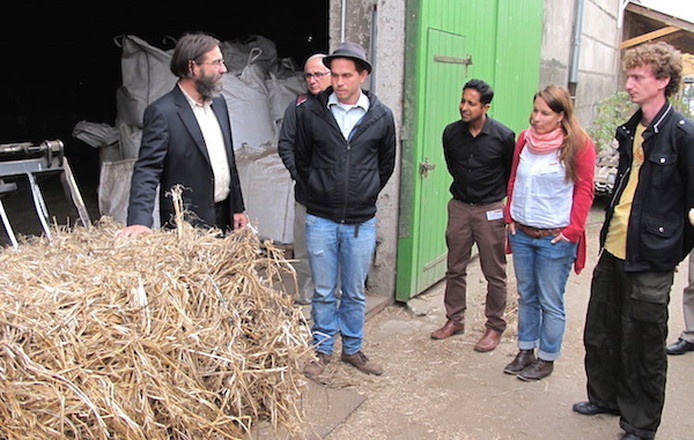If you want to see the hemp industry flowering, head for Prenzlau. That’s where the German firm Hanffaser (literally translated as “Hempfibre”) is powering rural economic development by pulling together local farmers and entrepreneurs in a sparkling demonstration of The Hemp Dream.
Located in the Uckermark District of Brandenburg in northeastern Germany, the firm is playing a leading role shaping the local economy as civic leaders in the Town of Prenzlau (pop. 20,000) have made a conscious effort to encourage local businessmen in the bio-based and renewables industries.
The key link in a local hemp value chain, Hanffaser itself is an industrial-sized production facility that turns out hemp insulation, shiv for hemp-lime and hemp-clay construction, along with semi-finished hemp products for the bio-composite and non-woven materials niches. The factory processes hemp grown on 400 hectares (about 1,000 acres) of farmland within a 120-kilometer radius (about 75 miles) spanning the German-Polish border through its customized production line based on technology from Temafa, the German machine maker.
Cooperation, innovation
But while Hanffaser is a critical component, the heart of the local economic initiative is a cooperative of local farmers and innovators who work together on a wide range of hemp projects supporting each other.
“The real benefit of the cooperative is the diversity of its members,” said Rainer Nowotny, founder of the Hanffaser factory. Working as close partners, the members bring expertise from farming, mechanical and electrical engineering, marketing and sales to completely round out the local value chain, he noted. “Our idea is to strengthen the general productive atmosphere of friendship into a strategic collaboration that all members can benefit from,” Nowotny added.
The combination of expertise — and energy — via the cooperative has resulted in the development of technology, farming methods, product and processing formulas along with best practices and standards for such things as organic farming and the 100% usage of raw materials and waste, Nowotny said.
“Everything we’ve developed has been through cooperation of our members,” said Nowotny, noting that over the past three years the group has engineered an industrial-sized hemp-seed harvesting machine under a project led by Dutch entrepreneur and biologist Marijn Roersch van der Hoogte; launched into a line of hemp-lime products for the construction industry; and developed a processing line for cavity blow-in insulation material.
“The cooperative offers a great platform for rapid innovation and development of renewable building materials,” said Roger Dauer, a German architect and co-op member who’s helping the group develop its line of hemp-lime construction products. “Whenever there’s a problem, cooperative members are often involved in implementation and continuous development,” said Dauer, who also studied the Chinese hemp industry while working as architect for Chinese and German architecture firms in Beijing.
Down to the market
Beyond its research and development initiatives for agriculture and processing machines, the co-op extends its hemp value chain into marketing via direct sales through 40 member-operated natural building supply retail outlets, one of which is located in the same facility as the processing factory. The company also has distribution through unaffiliated eco-building retailers across Germany.
Perhaps one of the co-op’s greatest achievements is an international bridging of business interests — and friendships — via its operating area that spans the borders of Germany and Poland, two nations with historically tense relations. “In day-to-day business the best way to overcome prejudice is self-irony,” Nowotny said. “Young Polish people are good at working together — we joke about German and Polish habits and customs. This makes cooperation easier and fights prejudice on both sides with a smile on your face.”
Getting to its current level of development didn’t happen for the Hanffaser-centered cooperative overnight. “The first 17 years was just a time of reaching the age of maturity,” Nowotny said. “It took time to lay the foundations necessary to realize ambitious projects. Everything had to be developed and built from scratch — the machines and processing lines, the licenses and standards, public awareness and the network of partners and natural building materials suppliers,” he added.
A flywheel effect
Now that it’s reached that level of maturity, Nowotny begins to feel a “flywheel effect.”
“A machine might produce energy, but if you want it to be powerful you need to combine it with the right flywheel,” he said. “That’s the task of the cooperative — to energize all activities and economic development of Hanffaser Uckermark.”
Dauer, as an architect, sees even broader power in the cooperative in its work promoting sustainability through truly green building materials.
“Germany’s approach to green building codes is a bit controversial, in my view,” he said. “As long as you follow the officially promoted plan and keep on boosting the energy efficiency of a building by any means — especially using PUR foam as insulation — everything is in order and manageable; such as fire protection and financial support by the state and so on.
“But once you start questioning this common standard and look for more sustainable solutions, like building materials based on renewable resources, the same standards and regulations can create obstacles,” he said.
“Of course, Hanffaser Uckermark itself cannot change this, but as cooperative members and partners we’re creating a network that is promoting a new kind of thinking. And together, we can change these things.”

